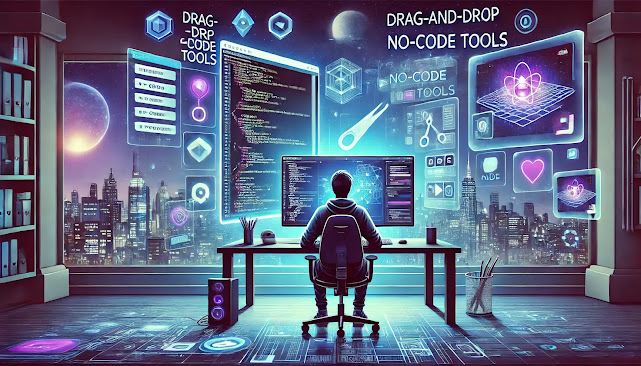Once upon a time, in a world not too different from our own, developers were revered as the sorcerers of the digital age. They conjured applications and websites with their mysterious spells (also known as code), and most people didn’t dare question their wizardry. But then, like a sudden plot twist in a Bollywood movie, no-code platforms arrived. They came with bright banners and catchy slogans: “No coding needed! Build apps in minutes!” Suddenly, everyone from your friendly neighborhood shopkeeper to your tech-savvy aunt could create their own app.
Cue the chaos. Developers began whispering in hushed tones: “Are we being replaced?!” Is this just another passing fad, or are we witnessing the beginning of the end for traditional coding? Let’s unpack this.
What Exactly Is No-Code?
Before you start picturing robots typing out code while you sip chai, let’s clarify. No-code platforms, such as Webflow, Bubble, or Glide, are tools that allow users to build apps and websites without writing a single line of code. It’s like assembling IKEA furniture—you follow the instructions, drag and drop the pieces, and voilà! Your creation is ready (minus the inevitable leftover screws).
Think of it as the Netflix of development: accessible, user-friendly, and perfect for quick satisfaction. You don’t need to wrestle with JavaScript bugs or wonder why CSS behaves like a rebellious teenager. But here’s the real question: can these platforms truly replace a seasoned developer’s expertise?
Are Developers Doomed?
To cut straight to the chase: No. Developers are far from obsolete. However, no-code tools are shaking up the game in ways we can’t ignore. Let’s explore why no-code isn’t the apocalypse for coding but more like a new player on the field.
Complex Projects Still Need Pros
Sure, no-code platforms are great for basic projects. You need a blog or a straightforward portfolio? No problem. But try building a complex ERP system, a machine learning model, or a social media platform like Instagram on no-code tools. You’ll hit a wall faster than an Indian traffic jam during Diwali.Customization is Key
No-code tools come with prebuilt templates and features, which is wonderful until you need something unique. Need a highly customized AI-powered chatbot or specific third-party integrations? You’ll soon realize that no-code tools are like pre-packaged dosas—they’re good but can’t compare to the fresh, hot-off-the-tawa version made by a skilled chef (a.k.a. a developer).Developers Are Problem Solvers, Not Just Coders
Here’s the thing: coding isn’t just about writing lines of syntax. It’s about solving real-world problems, optimizing performance, and creating seamless user experiences. No-code tools can give you the bricks, but they don’t provide the architectural plans. Developers are the architects who think about scalability, security, and maintainability.
A Personal Anecdote for the Soul
Let me tell you a story. A couple of years ago, I got curious about these no-code tools and decided to give one a whirl. It was amazing. Within an hour, I had a functional app prototype, and I felt like Tony Stark building Iron Man’s suit in his garage.
But then came the plot twist. I wanted to add a feature that wasn’t supported by the platform. I searched forums, tried hacks, and even considered sacrificing my sleep to figure it out. In the end, I hit the dreaded “Sorry, this feature isn’t available” message. That’s when I realized: no-code tools are great for starters, but if you want to go gourmet, you need to get back to the kitchen (or the IDE, in this case).
Why Developers Should Care About No-Code
Instead of worrying, developers should embrace no-code as a tool to make their lives easier. Think of it as your loyal sidekick, like Robin to your Batman or Watson to your Sherlock. Here’s how it can help:
- Rapid Prototyping: Want to pitch a new idea to your boss? Build a prototype in hours, not days.
- Focus on the Fun Stuff: Let no-code handle the mundane parts, so you can dive into more challenging tasks.
- Collaboration Made Simple: No-code makes it easier for non-technical team members to contribute, reducing your workload.
Pop Culture Break!
Remember that famous meme: “Thanos was right”? Well, maybe no-code platforms are like Thanos—inevitable. But unlike Thanos, they’re not here to wipe out developers. They’re here to snap away the boring bits of coding.
Final Thoughts: The Best of Both Worlds
The rise of no-code isn’t a storm to be weathered; it’s an opportunity. Developers who learn to integrate no-code tools into their workflow will work smarter, not harder. Think of it this way: no-code is like the calculator. When it came out, mathematicians didn’t lose their jobs—they just got faster at solving problems.
So, should you be worried? Not really. Keep upskilling, stay adaptable, and remember: whether you’re using no-code, Python, or C++, the real magic lies in your ability to think, create, and solve problems.
And who says you can’t have fun with it? After all, every Iron Man needs their Jarvis, and every coder deserves a tool that makes life a little easier.

Comments
Post a Comment